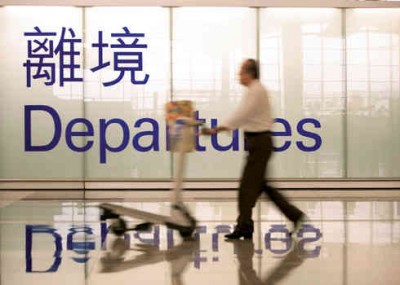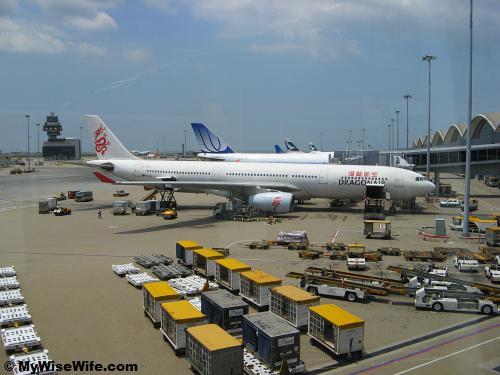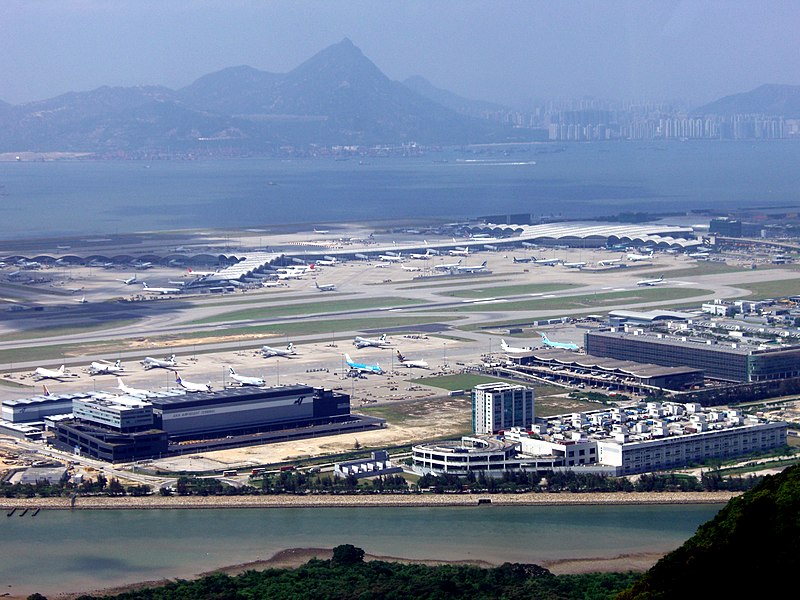Hong Kong !!
-
Hong Kong International Airport is the main airport in Hong Kong. It is colloquially known as Chek Lap Kok Airport (èµ¤é±²è§’æ©Ÿå ´), because it was built on the island of Chek Lap Kok by land reclamation, and also to distinguish it from its predecessor, the closed Kai Tak Airport.
The airport opened for commercial operations in 1998, replacing Kai Tak, and is an important regional trans-shipment centre, passenger hub and gateway for destinations in Mainland China (with over 40 destinations) and the rest of Asia. Despite a relatively short history, Hong Kong International Airport has won seven Skytrax World Airport Awards for customer satisfaction in just ten years. However, HKIA ranked second and third in 2009 and 2010 respectively for the Skytrax World Airport Awards, although it still remains as the best airport taking into account passenger numbers annually.
HKIA also operates one of the world's largest passenger terminal buildings (the world's largest when opened in 1998) and operates twenty-four hours a day. The airport is operated by the Airport Authority Hong Kong and is the primary hub for Cathay Pacific Airways, Dragonair, Hong Kong Express Airways, Hong Kong Airlines, and Air Hong Kong (cargo). It is a focus city for Air New Zealand, China Airlines, Vietnam Airlines to a lesser extent Qantas and Virgin Atlantic, all of which use Hong Kong as a stopover point for flights on the Kangaroo Route between Australasia and Europe. Both United Airlines and Air India use Hong Kong as a stopover point for flights respectively from the United States to Singapore and Ho Chi Minh City as well as from India to Osaka and Seoul. In the near future, Garuda Indonesia is considering making Hong Kong their transit hub for flights to Europe.
-
Flights are operated by roughly 90 airlines to over 150 cities across the globe, and in 2009 it was the 13th busiest airport worldwide in terms of passenger throughput, registering 45,560,888. HKIA is also an important contributor to the Hong Kong economy, with 60,000 people employed at the airport.

In 2009, it was the second busiest airport in the world in terms of cargo traffic, handling 3,384,765 tons of cargo.
-
Hong Kong International Airport was built on a large artificial island, formed by levelling Chek Lap Kok and Lam Chau islands (3.02 km² and 0.08 km² respectively), and reclaiming 9.38 km² of the adjacent seabed. The 12.48 km² airport site added nearly 1% to Hong Kong's total surface area, connecting to the north side of Lantau Island near Tung Chung new town.

-
Construction of the new airport was only part of the Airport Core Programme, which also involved construction of new road and rail links to the airport, with associated bridges and tunnels, and major land reclamation projects on both Hong Kong Island and in Kowloon. The project is the most expensive airport project ever, according to Guinness World Records. Construction of the new airport was voted as one of the Top 10 Construction Achievements of the 20th Century at the ConExpo conference in 1999.
With one of the world's largest airport terminals, the ability to withstand an intense typhoon was a major concern. The sides of the terminals, predominantly glass, were designed to break during high speed winds, relieving pressure and allowing the terminal to remain standing.
-

-
Opened on 6 July 1998, a week later than the new Kuala Lumpur International Airport, it took six years and US$20 billion to build. On that day at 6:25 am, Cathay Pacific flight 889 was the first commercial flight to land at the airport, pipping the original CX292 from Rome which was the scheduled first arrival. The architects were Foster and Partners.
However, on the first day of opening, the airport had already started to experience some technical difficulties. The flight information display system (FIDS) had suddenly shut down which caused long delays.

HKIA simply could not keep up without an automated computer assisting. For three to five months after its opening, it suffered various severe organisational, mechanical, and technical problems that almost crippled the airport. Computer glitches were to blame for the crisis.
-
The airport has a total of 70 boarding gates, with 63 jet bridge gates and seven virtual gates which are used as assembly points for passengers, who are then ferried to the aircraft by apron buses.
Of the 63 jet bridges, five are capable of handling the Airbus A380. The Singapore Airlines A380 currently operates to Hong Kong and uses those gates.


-
Terminal 1
Terminal 1 of the HKIA is currently the third largest airport passenger terminal building in the world (570,000 m²), after Dubai International Airport's Terminal 3 (1,500,000 m²) and Beijing Capital International Airport's Terminal 3 (986,000 m²).
At its opening, Terminal 1 was the largest airport passenger terminal building, with a total gross floor area of 550,000 m². It briefly conceded the status to Bangkok's Suvarnabhumi Airport (563,000 m²) when the latter opened on 15 September 2006, but reclaimed the title when the East Hall was expanded, bringing the total area to its current size (the East Hall expansion included a 39,000 m² expansion to SkyMart, a shopping mall). Terminal 1's title as the world's largest was surrendered to Beijing's airport's Terminal 3 on 29 February 2008.


-
Terminal 2
Terminal 2, together with the Skyplaza, opened on 28 February 2007 along with the opening of the Airport Station's Platform 3. It is only a check-in and processing facility for departing passengers with no gates or arrival facilities (passengers are transported underground to gates at Terminal 1).
So far a majority of low-cost carriers and some full-service carriers have relocated their check-in operations to T2. The SkyPlaza is situated within Terminal 2. Architecture firm Skidmore, Owings and Merrill designed Terminal 2 and the SkyPlaza.



-
HKIA inside..

-

-

-
Hong Kong International Airport, Arrival Hall 6.
-
-
-

-

-

-

-
-
-

-

-
_B-HUK@HKIA.jpg)




